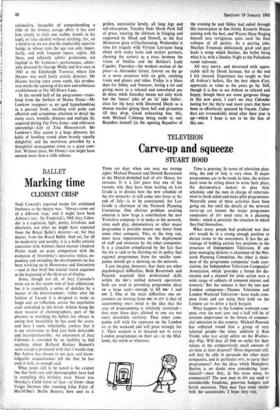Marking time
BALLET CLEMENT CRISP
Noel Coward's reported recipe for continued freshness in the theatre was: 'Always come out of a different trap,' and it might have been Ashton's too: Sir Frederick's 1968 Jazz Calen- dar is a capriccio, light, pretty, frivolous, and absolutely not what we might have expected from the Royal Ballet's director—or, for that matter, from the Royal Ballet. And yet, for all its modernity and novelty, it is a ballet entirely consistent with Ashton's latest manner (Andrew Porter made an acute comparison with the evolution of Stravinsky's successive styles), ex- pending and extending the developments he has been working on in Monotones and Sinfonietta —and in that brief but crucial vision sequence at the beginning of the third act of Ondine.
Some, though not all, of Jazz Calendar's roots are in this recent vein of lean athleticism, but it is essentially a series of sketches by a master of the divertissement : rather after the fashion of Facade it is designed to make us laugh and, on reflection, savour the superlative craft embodied in this frivol. Ashton being the most musical of choreographers, part of the pleasure in watching his ballets lies always in seeing how beautifully he has used the score; and here I must, reluctantly, confess that it is my misfortune to find jazz both detestable and incomprehensible : my enjoyment of Jazz Calendar is corroded by an inability to feel anything about Richard Rodney Bennett's score except a profound wish that it would stop. But Ashton has chosen to use jazz, and know- ledgeable acquaintances tell me that he has used it well, so enough said.
What needs still to be noted is the evident fan that both cast and choreographer have had in compiling this birthday treat. Never was Monday's Child fairer of face—or form—than Vergie Derman (the stunning Lilac Fairy of MacMillan's Berlin Beauty), here seen as a golden, narcissistic lovely, all long legs and self-absorption. Tuesday finds Merle Park full of grace, wearing the ultimate in fringing and supported by Mead and Dowell, as the first Monotone gone a-Charlestoning. Wednesday is time for tragedy with Vyvyan Lorrayne hung about with snaky locks and snakier partners, chewing the scenery as a cross between the vision of Ondine and the Bolshoi's Lady Capulet. Thursday—the weakest section of the piece—is Alexander Grant, forever on the go in a moto perpetuo with six girls, catching trains and planes and tubes. Friday is a blues duet for Sibley and Nureyev, loving a lot and giving more to a relaxed and convoluted pas de deux, while Saturday means not only work but the `innese joke of an 'in' joke ballet: class for the boys with Desmond Doyle as a demon teacher giving them hell and pirouettes till they drop. Good exhausting fun, this, with Michael Coleman being made to out- Bayadere himself (in the opening Bayadere of the evening he and Sibley had sailed through this masterpiece in fine form), Kenneth Maim soaring with the best, and Wayne Sleep flinging himself into vertiginous spins until the final collapse of all parties. As a parting joke, Marilyn Trounson (deliciously good and gay) leads a romp which finishes, the ballet being what it is, with a Sunday Night at the Palladium ronde infernale.
All very merry, and decorated with appre- ciable skill by Derek Jarman; but at the end I felt cheated. Experience has taught us that all Ashton's ballets, like the best objets d'art, appreciate in value as the years go by. Still, though it is fine to see Ashton so relaxed and happy, though there are some gorgeous things in this new piece, I can't see Jazz Calendar lasting for the thirty and more years that have been so effortlessly spanned by Facade. Calen- dars are irremediably dated after their year is up—which I hope is not to be the fate of this one.


































 Previous page
Previous page